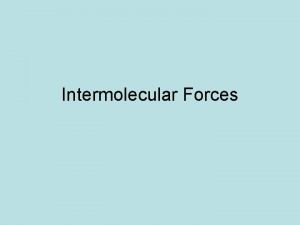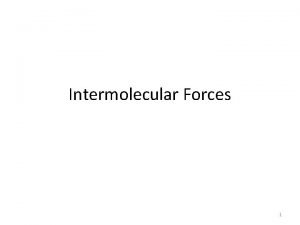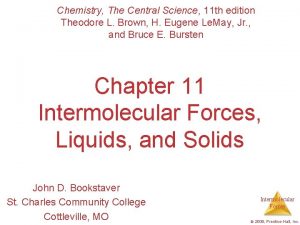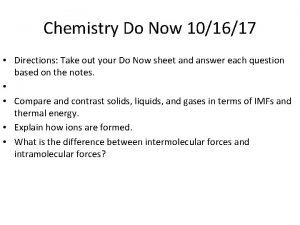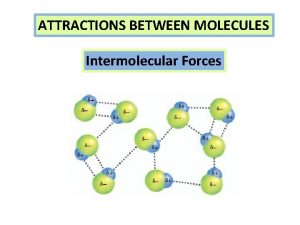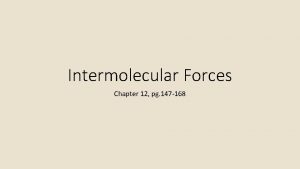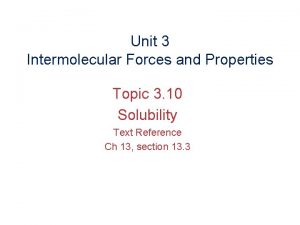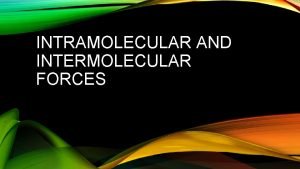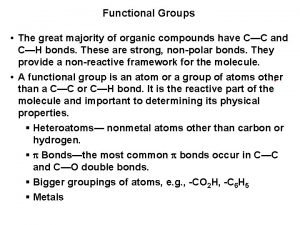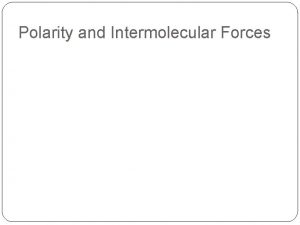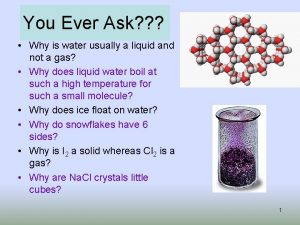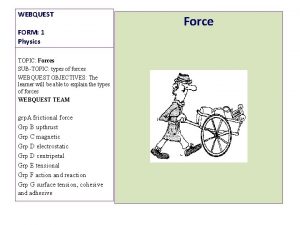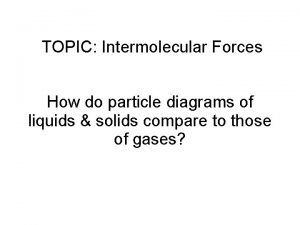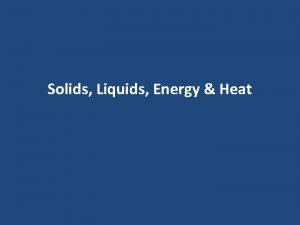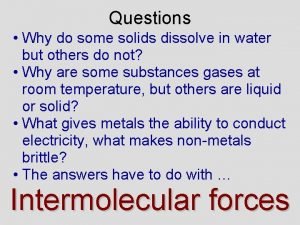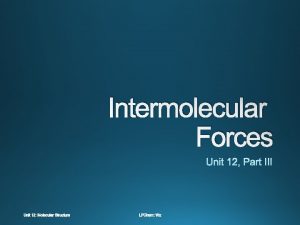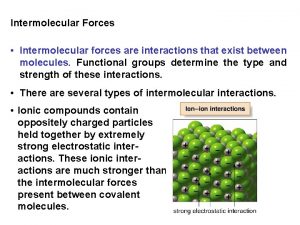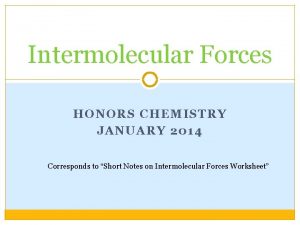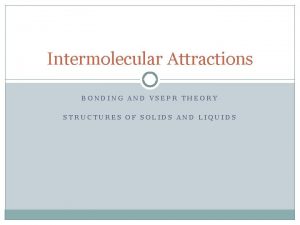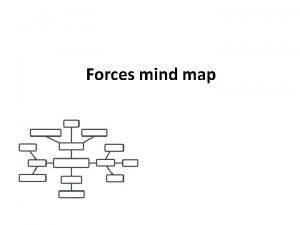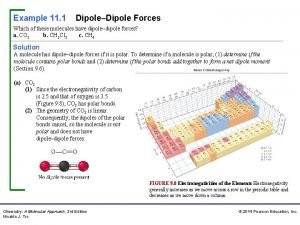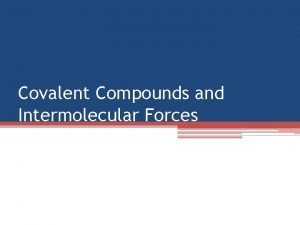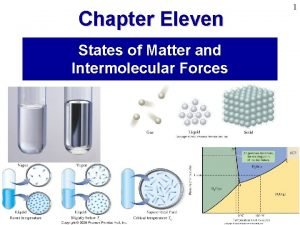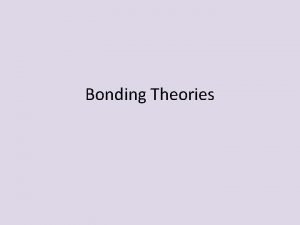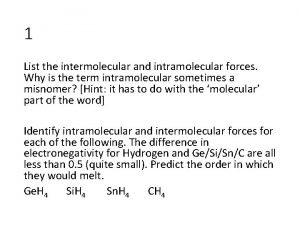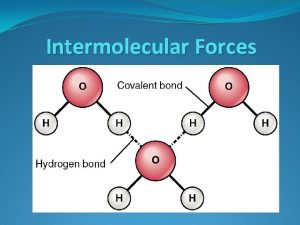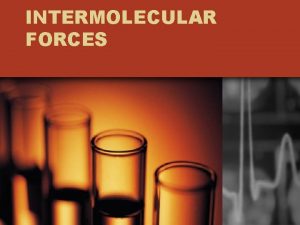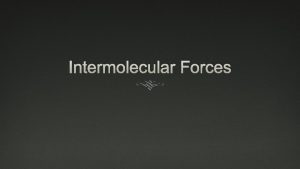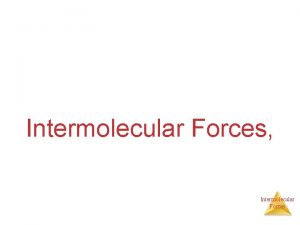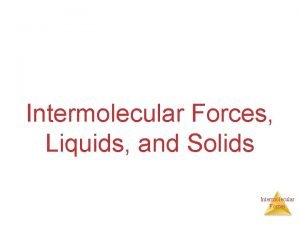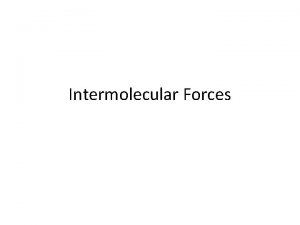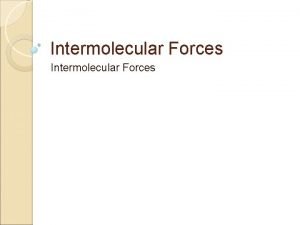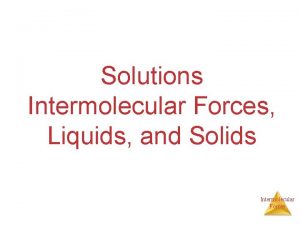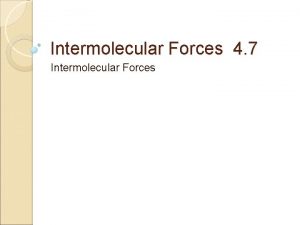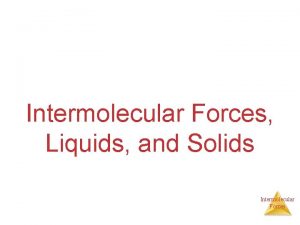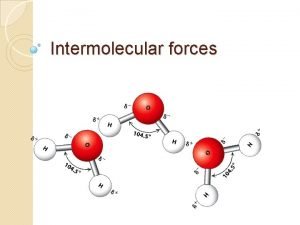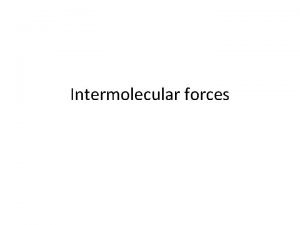Chapter 7 Intermolecular Forces and the Phases of






































- Slides: 38

Chapter 7 – Intermolecular Forces and the Phases of Matter Please turn cell phones off 3. 5 © 2010 -13 J. E. Johnson (Worksheet available on Web. CT) 1

7. 1 Why Does Matter Exist in Different Phases? From Chapter 1, Physical Changes: Ø Changes in matter that do not result in changing the molecules present e. g. ) Phase changes: physical changes from one “phase” or “state” of matter to another © 2010 -13 J. E. Johnson 2

3 most common Phases: 1. Gases • Average speed of gaseous particles depends on T • How? T = average KE and KE = ½ mass × speed 2 • Thus, T is directly related to speed © 2010 -13 J. E. Johnson 3

3 most common Phases: 1. Gases • Average speed of gaseous particles depends on T • How? T = average KE and KE = ½ mass × speed 2 • Thus, T is directly related to speed • Gas particles move too quickly to attract one another • Thus, gases have no structure and particles remain far apart © 2010 -13 J. E. Johnson 4

3 most common Phases: 1. Gases 2. Liquids • Liquid particles move slower than gas particles. . . they weakly attract one another (don’t have enough kinetic energy to get away) • have IMFs between liquid particles that bind them together loosely (disordered structure) IMFs: intermolecular forces – attractions/repulsions between particles © 2010 -13 J. E. Johnson 5

3 most common Phases: 1. Gases 2. Liquids 3. Solids • Solid particles move the slowest. . . they strongly attract one another (have very low kinetic energy) • Thus, IMFs between solid particles bind them together more strongly than liquids • form crystal lattice: highly-ordered structure For more in-depth imagery of 3 phases. . © 2010 -13 J. E. Johnson 6

Ø Moving among phases (Phase Changes): 1. Vaporization (l → g) • reverse: Condensation (g → l) 2. Fusion (s → l) • reverse: Crystallization (l → s) 3. Sublimation (s → g) • reverse: Deposition (g → s) fusion deposition sublimation condensation © 2010 -13 J. E. Johnson 7

7. 2 Intermolecular Forces (IMFs) Ø In Chapters 5 and 6, we learned that: Ø Polar molecules: Have a net dipole moment Ø Nonpolar molecules: Have NO net dipole moment 1. Dipole-dipole IMFs: Ø attractions that occur between polar molecules ●● ●● © 2010 -13 J. E. Johnson ●● H Cl δ- ●● H Cl ●● δ- ●● δ+ δ+ 10

7. 2 Intermolecular Forces (IMFs) Ø In Chapters 5 and 6, we learned that: Ø Polar molecules: Have a net dipole moment Ø Nonpolar molecules: Have NO net dipole moment 1. Dipole-dipole IMFs: Ø attractions that occur between polar molecules Now, let’s learn about 2 more δ+ IMFs! ● ● δ●● ●● © 2010 -13 J. E. Johnson ●● H Cl δ- H Cl ●● ●● δ+ 11

7. 2 Intermolecular Forces (IMFs) Ø In Chapter 6, we discovered that: Ø CO 2 is a nonpolar molecule So, what IMFs keep CO 2(s) molecules together? © 2010 -13 J. E. Johnson 12

7. 2 Intermolecular Forces (IMFs) Ø What IMFs keep CO 2 molecules together? 2. London Dispersion IMFs Ø Also called van der Waals IMFs © 2010 -13 J. E. Johnson 13

How London Dispersion IMFs work: e. g. ) Let’s imagine CH 4 as a sphere of electrons © 2010 -13 J. E. Johnson 14

How London Dispersion IMFs work: e. g. ) CH 4 as a sphere of electrons © 2010 -13 J. E. Johnson 15

How London Dispersion IMFs work: e. g. ) CH 4 as a sphere of electrons Ø This temporary dipole sets up weak attractions between molecules = London Disperson IMFs © 2010 -13 J. E. Johnson 16

7. 2 Intermolecular Forces (IMFs) 1. Dipole-Dipole IMFs • Exhibited only between polar molecules 2. London Disperson IMFs • Exhibited among all types of molecules (i. e. , polar and nonpolar molecules have them) Ø Generally, molecules exhibiting only London Dispersion IMFs are held together more weakly than molecules exhibiting Dipole-Dipole IMFs • Polar molecules exhibit both London Dispersion and Dipole-dipole IMFs; dominant IMF = Dipole-dipole © 2010 -13 J. E. Johnson 17

7. 2 Intermolecular Forces (IMFs) e. g. ) Which would have a lower boiling point (i. e. , require less E to vaporize), CH 4 or NOF? 1. Decide if polar or nonpolar • CH 4 is nonpolar © 2010 -13 J. E. Johnson • NOF is polar 18

e. g. ) Which would have a lower boiling point (i. e. , require less E to vaporize), CH 4 or NOF? 1. Decide if polar or nonpolar 2. Decide which IMFs each would exhibit • CH 4 is nonpolar Ø will exhibit London Dispersion IMFs between CH 4 molecules • NOF is polar Ø will exhibit Dipole-Dipole IMFs AND London Dispersion IMFs between NOF molecules Ø Thus, we would expect CH 4 to vaporize at a lower T because NOF molecules are held together with more IMFs © 2010 -13 J. E. Johnson 19

1. Dipole-dipole IMFs • Exhibited only between polar molecules 2. London Disperson IMFs • Exhibited between all types of molecules 3. Hydrogen Bonding IMFs • A unique dipole-dipole interaction that is exhibited only between polar molecules possessing H attached to F, O, or N • Due to large ∆EN and small size of atoms involved • Thus, molecules can get close © 2010 -13 J. E. Johnson 20

7. 3 Hydrogen Bonding ** Hydrogen must be attached to F, O, or N for Hbonding to occur ** Ø Easy way to remember: “H-bonding is FON” © 2010 -13 J. E. Johnson 21

1. Dipole-dipole IMFs: Exhibited only between polar molecules 2. London Disperson IMFs: Exhibited between all types of molecules 3. Hydrogen Bonding IMFs: Exhibited only between polar molecules possessing H attached to F, O, or N Ø Generally, molecules exhibiting only London Dispersion or Dipole-Dipole IMFs are held more weakly than molecules exhibiting Hydrogen Bonding IMFs • Polar molecules with H attached to F, O, or N are held together by London Dispersion, Dipole-Dipole, AND Hydrogen Bonding IMFs; dominant IMF = Hydrogen Bonding © 2010 -13 J. E. Johnson 22

Let’s Practice: Intermolecular Forces Ø Place the following in order of increasing (lowest to highest) boiling point: Ø Boiling Point: T at which liquid becomes vapor © 2010 -13 J. E. Johnson 23

Solution: Place the following in order of increasing boiling point Ø CH 2 O (formalehyde) is polar. . . IMFs? Ø Dipole-dipole IMFs and London Dispersion IMFs (dominant) © 2010 -13 J. E. Johnson 24

Solution: Place the following in order of increasing boiling point Dipole-Dipole and London Dispersion Ø CO 2 is nonpolar. . . IMFs? Ø London Dispersion IMFs only (dominant) © 2010 -13 J. E. Johnson 25

Solution: Place the following in order of increasing boiling point London Dispersion Dipole-Dipole and London Dispersion Ø NH 3 is polar. . . IMFs? Ø London Dispersion, Dipole -Dipole, and Hbonding IMFs (dominant) © 2010 -13 J. E. Johnson 26

Solution: Place the following in order of increasing boiling point > © 2010 -13 J. E. Johnson > London Dispersion (dominant) Dipole-Dipole (dominant) and London Dispersion Dipole-Dipole, London Dispersion, and H-bonding (dominant) 27

Extra e. g. ) Place the following substances in order of increasing boiling point: © 2010 -13 J. E. Johnson 28

Extra e. g. ). . . in order of increasing boiling point: (Highest) (Higher) (Lowest) Dipole-Dipole, London Dispersion, and MORE H-bonding Dipole-Dipole, London Dispersion, and MOST H -bonding Dipole-Dipole, London Dispersion, and H-bonding © 2010 -13 J. E. Johnson 29

Summary of IMFs Ø Generally, order of IMF strength is: (1) London Dispersion (weakest) © 2010 -13 J. E. Johnson δδ- + + δ δ : O N: : O : N δ- : F : : : (3) Hydrogen Bonding (least weak) δδ+ : : : (2) Dipole-Dipole (weaker) δδ- H : O: H 30

Summary of IMFs But remember. . . strength of London Dispersion forces are based on # of e-s Ø If a molecule has lots of e-s, it will have lots of London Dispersion IMFs Ø MORAL: it might attract molecules like itself more strongly e. g. ) I 2(s) vs. HCl(g) at room T London Dispersion δδ+ δδ- : : O : F N: δ+ δ- : : © 2010 -13 J. E. Johnson δ- : : Dipole-Dipole δδ- δδ+ : F N: δ+ 31

Two types of Solids From Chapter 5: 1. Molecular solids: made up of individual molecules and are held together by weak IMFs • melting/boiling points dependent on relative IMF strengths ice melts ~ 0 o. C CO 2(s) sublimes – 79 o. C Se 8 melts ~221 o. C © 2010 -13 J. E. Johnson 32

7. 5 Nonmolecular Solids 1. Molecular solids: made up of individual molecules and are held together by weak IMFs molecules 2. Nonmolecular solids: any solid that is not a molecular solid A. Ionic solids (Chapter 5): are held together by strong ionic (Coulombic) attractions between cations and anions Ionic Melting Point Solid (o. C) Mg. O 2852 Ba. O 1923 Na. Cl 801 KCl 790 © 2010 -13 J. E. Johnson 33

1. Molecular solids: made up of individual molecules and are held together by IMFs molecules 2. Nonmolecular solids: any solid that is not a molecular solid A. Ionic solids: are held together by strong ionic (Coulombic) attractions between cations and anions (high melting points > 1000 o. C) B. Network – covalent solids: held together by covalent forces between atoms • have even higher melting/boiling points e. g) diamond melts ~ 3550 o. C Si. O 2 melts ~ 1610 o. C © 2010 -13 J. E. Johnson 34

7. 5 Nonmolecular Solids © 2010 -13 J. E. Johnson 35

1. Molecular solids: made up of individual molecules and are held together by IMFs molecules 2. Nonmolecular solids: any solid that is not a molecular solid A. Ionic solids: are held together by strong ionic (Coulombic) attractions between cations and anions (high melting points > 1000 o. C) B. Network – covalent solids: held together by covalent forces between atoms (even higher melting/boiling pts) C. Metallic solid: held together by metallic bonding between atoms • have variable melting and boiling points © 2010 -13 J. E. Johnson 36

Metallic bonding: Ø Neutrally-charged, metal atoms held together by sharing valence e-s moving through metal sample Ø Valence e-s form “sea of e-s” that are shared by all nuclei Ø “Sea of e-s” forms because valence e-s of metals are held loosely Ø Thus, it’s easy to dislodge them and have all metallic atoms in the sample share them © 2010 -13 J. E. Johnson 37

Let’s Practice: Types of Solids Ø Classify the following solids as MOLECULAR, IONIC, or METALLIC. Which would conduct electricity? A) I 2(s) B) Ca. Br 2 (s) C) NH 4 NO 3(s) D) K(s) © 2010 -13 J. E. Johnson 38

Solution: Classify the following solids. Which would conduct electricity? A) I 2(s) • Molecular solid B) Ca. Br 2 (s) • Ionic solid C) NH 4 NO 3(s) • Ionic solid D) K(s) • Metallic solid © 2010 -13 J. E. Johnson 39

** DON’T FORGET ** Take the Chapter 7 Quiz - it’s available on Web. CT after 7 pm tonight! © 2010 -13 J. E. Johnson 40
 Intramolecular forces
Intramolecular forces Difference between intermolecular and intramolecular
Difference between intermolecular and intramolecular Inter vs intramolecular forces
Inter vs intramolecular forces Intermolecular forces present in hbr
Intermolecular forces present in hbr Gecko feet facts
Gecko feet facts Intermolecular forces
Intermolecular forces Viscosity and intermolecular forces
Viscosity and intermolecular forces Intermolecular forces capillary action
Intermolecular forces capillary action Nof intermolecular forces
Nof intermolecular forces Pg 147
Pg 147 Unit 3 intermolecular forces and properties
Unit 3 intermolecular forces and properties Dipole induced dipole interaction
Dipole induced dipole interaction Electronegativity intermolecular forces
Electronegativity intermolecular forces Functional groups and intermolecular forces
Functional groups and intermolecular forces Intermolecular forces review
Intermolecular forces review Ch2cl intermolecular forces
Ch2cl intermolecular forces Intermolecular forces webquest answers
Intermolecular forces webquest answers Intermolecular forces
Intermolecular forces 3 types of intermolecular forces
3 types of intermolecular forces Imf chem
Imf chem How do intermolecular forces affect solvation?
How do intermolecular forces affect solvation? Dipole dipole interaction example
Dipole dipole interaction example Phthatic
Phthatic Dimethyl ether dipole dipole
Dimethyl ether dipole dipole Intermolecular forces symbol
Intermolecular forces symbol Strength of intermolecular forces
Strength of intermolecular forces Strength of intermolecular forces
Strength of intermolecular forces Van der waals attraction
Van der waals attraction Strongest to weakest intermolecular forces
Strongest to weakest intermolecular forces Intermolecular forces strongest to weakest
Intermolecular forces strongest to weakest Type of intermolecular forces
Type of intermolecular forces Dipole dipole
Dipole dipole Mind mapping about intermolecular forces
Mind mapping about intermolecular forces Ch2cl intermolecular forces
Ch2cl intermolecular forces Coh2 intermolecular forces
Coh2 intermolecular forces Intermolecular force
Intermolecular force Types of van der waals forces
Types of van der waals forces Intermolecular forces ap chemistry
Intermolecular forces ap chemistry Intramolecular forces list
Intramolecular forces list




